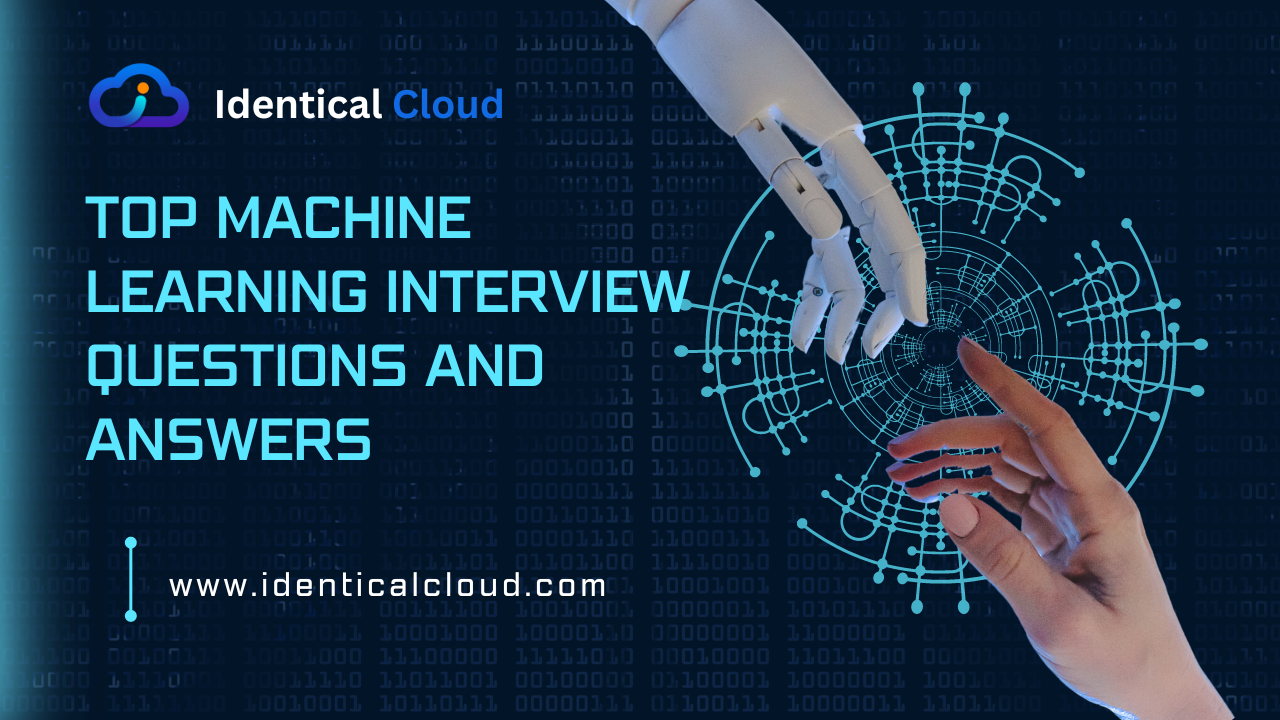
Top machine learning Interview Questions and Answers
Top machine learning Interview Questions and Answers
Machine learning is a rapidly growing field with many potential applications. As a result, there is a high demand for skilled machine learning professionals. If you are interviewing for a machine learning position, it is important to be prepared for a variety of questions.
Here are the top machine learning interview questions and answers:
What is machine learning?
Machine learning is a type of artificial intelligence (AI) that allows computers to learn without being explicitly programmed. Machine learning algorithms are trained on data, and they use this data to make predictions or decisions.
What are the different types of machine learning?
There are three main types of machine learning: supervised learning, unsupervised learning, and reinforcement learning.
- Supervised learning is the most common type of machine learning. In supervised learning, the algorithm is given labeled data, which means that the data has been tagged with the correct output. The algorithm uses this labeled data to learn how to make predictions.
- Unsupervised learning is used when the data does not have labels. The algorithm is used to find patterns and relationships in the data.
- Reinforcement learning is used when the algorithm learns by trial and error. The algorithm is given a reward for taking actions that lead to desired outcomes, and it is penalized for taking actions that lead to undesired outcomes.
What are the steps involved in building a machine learning model?
The steps involved in building a machine learning model are:
- Gather the data. The first step is to gather the data that the model will be trained on. This data should be representative of the problem that the model is trying to solve.
- Clean the data. The data needs to be cleaned before it can be used to train the model. This means removing any errors or inconsistencies in the data.
- Choose the algorithm. There are many different machine learning algorithms available. The algorithm that is chosen will depend on the type of problem that the model is trying to solve.
- Train the model. The model is trained by feeding it the data that has been cleaned and prepared. The model will learn to make predictions based on the data.
- Evaluate the model. Once the model has been trained, it needs to be evaluated. This means testing the model on data that it has not seen before.
- Deploy the model. Once the model has been evaluated and found to be accurate, it can be deployed to production. This means making the model available to users so that they can use it to make predictions.
What are the common challenges in machine learning?
There are many challenges in machine learning, including:
- Data quality: The quality of the data is critical to the success of a machine learning model. If the data is not clean or representative, the model will not be accurate.
- Overfitting: Overfitting occurs when the model learns the training data too well. This can lead to the model making inaccurate predictions on new data.
- Underfitting: Underfitting occurs when the model does not learn the training data well enough. This can also lead to the model making inaccurate predictions on new data.
- Bias: Bias can occur in machine learning models when the data is not representative of the population that the model is trying to predict. This can lead to the model making inaccurate predictions for certain groups of people.
- Variety: Machine learning models can be sensitive to the variety of data that they are trained on. If the data is not diverse enough, the model may not be able to generalize to new data.
What are the ethical considerations of machine learning?
Machine learning models can be used to make decisions that have a significant impact on people’s lives. As a result, it is important to consider the ethical implications of using machine learning. Some of the ethical considerations include:
- Fairness: Machine learning models should not be used to discriminate against certain groups of people.
- Privacy: Machine learning models should not be used to collect or store personal data without the consent of the people involved.
- Accountability: The people who develop and use machine learning models should be accountable for the decisions that the models make.
- Transparency: The people who use machine learning models should be able to understand how the models work and how they make decisions.
What are some of the most popular machine learning algorithms?
Some of the most popular machine learning algorithms include:
- Linear regression: This algorithm is used to predict a continuous value, such as the price of a house or the number of clicks on an ad.
- Logistic regression: This algorithm is used to predict a categorical value, such as whether a customer will click on an ad or not.
- Support vector machines: This algorithm is used to classify data into two or more categories.
- Decision trees: This algorithm is used to make decisions based on a set of rules.
- Random forests: This algorithm is a collection of decision trees that are used to make predictions.
- Neural networks: This algorithm is inspired by the way that the human brain works. It is used to solve a variety of problems, including image recognition and natural language processing.
What are the benefits of using machine learning?
Machine learning can offer a number of benefits, including:
- Accuracy: Machine learning models can be more accurate than traditional statistical methods.
- Scalability: Machine learning models can be scaled to handle large amounts of data.
- Automation: Machine learning models can automate tasks that would otherwise be done by humans.
- Innovation: Machine learning can be used to create new products and services.
What are the challenges of using machine learning?
There are also a number of challenges associated with machine learning, including:
- Data requirements: Machine learning models require large amounts of data to train.
- Complexity: Machine learning models can be complex and difficult to understand.
- Bias: Machine learning models can be biased, which can lead to inaccurate predictions.
- Interpretability: It can be difficult to interpret how machine learning models make decisions.
- Security: Machine learning models can be vulnerable to security attacks.
What are the future trends in machine learning?
The future of machine learning is bright. Machine learning is expected to be used in a wider range of applications, and the algorithms will become more accurate and efficient. Some of the future trends in machine learning include:
- Deep learning: Deep learning is a type of machine learning that uses artificial neural networks to learn from data. Deep learning is expected to be used in a wider range of applications, such as image recognition and natural language processing.
- Automated machine learning: Automated machine learning is a process that automates the steps involved in building and deploying a machine learning model. Automated machine learning is expected to make it easier for people to use machine learning.
- Explainable AI: Explainable AI is a field of research that focuses on making machine learning models more interpretable. Explainable AI is expected to help people understand how machine learning models make decisions.
- Federated learning: Federated learning is a type of machine learning that allows multiple devices to train a machine learning model without sharing their data. Federated learning is expected to be used in applications where data privacy is a concern.
Explain the difference between supervised and unsupervised learning.
Supervised learning involves training a model on labeled data, where inputs are paired with corresponding outputs. The model learns to predict output based on input. Unsupervised learning deals with unlabeled data, and the algorithm’s goal is to find patterns or structures within the data, such as clustering similar data points.
What is the bias-variance trade-off in machine learning?
The bias-variance trade-off refers to the balance between a model’s ability to fit training data (low bias) and its ability to generalize to new, unseen data (low variance). Models with high bias may oversimplify data, while high-variance models may overfit the training data.
Can you explain the concept of overfitting in machine learning?
Overfitting occurs when a model learns the training data too well, capturing noise and irrelevant details. As a result, the model may perform well on the training data but poorly on new, unseen data. Regularization techniques and cross-validation are used to combat overfitting.
What are precision and recall? How are they related?
Precision is the ratio of true positive predictions to the total predicted positives, while recall is the ratio of true positive predictions to the total actual positives. They are related in that increasing precision often leads to lower recall, and vice versa. The F1 score combines precision and recall for a balanced evaluation.
What is the ROC curve, and what does it represent?
The Receiver Operating Characteristic (ROC) curve is a graphical representation of the true positive rate (sensitivity) against the false positive rate (1-specificity) as a model’s discrimination threshold changes. The area under the ROC curve (AUC) is used to quantify the model’s performance; a higher AUC indicates better performance.
Explain the concept of cross-validation.
Cross-validation is a technique used to assess a model’s performance by partitioning the data into training and testing subsets multiple times. It helps validate a model’s performance on different subsets of data, reducing the risk of overfitting and providing a more accurate estimation of its generalization capabilities.
What is the difference between bias and variance in machine learning?
Bias is the error introduced by approximating a real-world problem, which may be complex, with a simplified model. Variance is the error introduced due to model sensitivity to small fluctuations in the training data. Bias and variance together impact a model’s overall predictive accuracy.
What are regularization techniques in machine learning?
Regularization techniques aim to prevent overfitting by adding a penalty term to the model’s loss function. L1 regularization (Lasso) adds the absolute values of coefficients, encouraging sparse solutions. L2 regularization (Ridge) adds the squared values of coefficients, discouraging large coefficients.
Can you explain the difference between bagging and boosting?
Bagging (Bootstrap Aggregating) involves training multiple instances of the same model on different subsets of the training data and averaging their predictions to reduce variance. Boosting, on the other hand, trains multiple weak learners sequentially, with each learner focusing on the errors made by the previous ones to improve overall performance.
What is gradient descent, and how does it work?
Gradient descent is an optimization technique used to adjust the parameters of a model in order to minimize the error or loss function. It involves calculating the gradient of the loss function with respect to the model’s parameters and updating the parameters in the direction that reduces the loss.
Explain the concept of a decision tree.
A decision tree is a supervised machine learning algorithm used for classification and regression tasks. It involves partitioning the feature space into subsets based on the values of different features. Each decision node represents a feature, and each leaf node represents a class label or a predicted value.
What is random forest, and why is it useful?
Random Forest is an ensemble learning technique that combines multiple decision trees to improve predictive accuracy and control overfitting. It introduces randomness through feature selection and data sampling, resulting in a robust and powerful model.
What are the different kernel functions used in Support Vector Machines (SVM)?
SVMs are capable of using different kernel functions to transform data into higher-dimensional space for better separation. Common kernel functions include:
- Linear Kernel
- Polynomial Kernel
- Radial Basis Function (RBF) Kernel
- Sigmoid Kernel
What is the curse of dimensionality, and why is it important in machine learning?
The curse of dimensionality refers to the challenges that arise when dealing with high-dimensional data. As the number of features increases, data becomes sparse, making it difficult to find meaningful patterns and relationships. It’s important in machine learning because it affects model performance, requires more data to generalize, and increases computational complexity.
What is the difference between classification and regression?
Classification is a supervised learning task that involves predicting a categorical label or class based on input features. Regression, also supervised, predicts a continuous numerical value as the output based on input features.
What is the role of activation functions in neural networks?
Activation functions introduce non-linearity to neural networks, allowing them to capture complex relationships in data. Common activation functions include:
- Sigmoid
- Hyperbolic Tangent (Tanh)
- Rectified Linear Unit (ReLU)
- Leaky ReLU
- Softmax (for multi-class classification)
What is feature engineering, and why is it important?
Feature engineering involves selecting, transforming, and creating relevant features from the raw data to improve model performance. Well-engineered features enhance a model’s ability to learn patterns and relationships in the data, leading to more accurate predictions.
Explain the concept of cross-entropy loss in classification tasks.
Cross-entropy loss, also known as log loss, measures the dissimilarity between the predicted probabilities and the actual labels in classification tasks. It’s used as a loss function to train models and assess their performance.
Can you explain the term “bias” in the context of machine learning algorithms?
In the context of machine learning, bias refers to the error introduced by approximating a real-world problem with a simplified model. High bias can lead to underfitting, where the model is too simple to capture the underlying patterns in the data.
These top machine learning interview questions provide a comprehensive overview of the knowledge and skills expected from machine learning candidates. While preparing for interviews, remember that practice, deep understanding, and practical application are key. Use these expert answers as stepping stones to build your expertise and tackle complex machine learning problems with confidence. Successful machine learning interviews not only demonstrate your theoretical understanding but also your ability to translate that knowledge into real-world scenarios and drive meaningful results.









